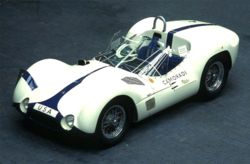- Maserati Tipo 61
-
Maserati Tipo 61 
Manufacturer Maserati Also called Birdcage Production 1959-1961
16 units[1]Class Sports racer. Body style Two-seat spyder. Layout FR layout Engine 2890.3 cc inline-four cylinder, Normally aspirated with two Weber 48 DC03 carburettors
187 kW (250 bhp) @ 6800 rpmTransmission 5 speed manual Wheelbase 2,200 mm (87 in) Curb weight 600 kg (1,300 lb) Related Maserati Birdcage 75th Designer Giulio Alfieri The Maserati Tipo 61 (commonly referred to as the Maserati Birdcage) is sports racing cars of the early 1960s. The car was produced between 1959 and 1961 by Maserati for racing in the 24 Hours of Le Mans endurance classic. It used an intricate tubular space frame chassis, containing about 200 chro-moly steel tubes welded together, hence the nickname "Birdcage".[1] This method of construction provided a more rigid and, at the same time, lighter chassis than other sports cars of the time.[1] By recessing the windscreen base into the bodywork, Maserati was able to reduce the effect of new Le Mans rules demanding a tall windscreen. The Camoradi team became famous racing the Tipo 61's but, despite being very competitive, the Birdcage was somewhat unreliable and occasionally retired from races due to problems with the drivetrain.[2] [3]
A modern car - the Maserati MC12 is available only in white and blue to serve as a tribute to the Tipo 61 and the Camoradi racing team.[4]
Contents
Racing history
The Tipo 61 was unveiled in 1959 when Stirling Moss won its first race, attracting the attention of Lloyd "Lucky" Casner.[5] Casner founded the Casner Motor Racing Division who raced three Tipo 61's in the 1960 24 Hours of Le Mans.[5] The Tipos never won Le Mans due to reliability issues, however in both 1960 and 1961 the Camoradi team won the 1000 km Nürburgring.[6]
The Birdcage series
The Tipo 61 was the most well known model but Giulio Alfieri designed 5 different models, all based on an intricate multi-tubular frame concept. This multi-tubular construction produced a light weight and rigid chassis that was a significant competitive advantage for a racing car. All models included independent front suspension, 4 wheel disc brakes and 5 speed transmission. A De Dion type rear axle was used on the Tipo 60 and 61.[3]
Tipo 60 featured a small 2 liter 4 cylinder engine of 200 hp (150 kW), located in the front and tilted over at a 45° angle for a lower center of gravity. The weight was 570 kg (1,257 lb) and the car had at a maximum speed of 270 km/h (168 mph).[3]
Tipo 61 featured a 2.9 liter 4 cylinder engine of 250 hp (186 kW), located in the front at a 45° angle for a weight of 600 kg (1,323 lb) pushing the car at a speed of 285 km/h (177 mph).[3]
The mid-engined Birdcage cars began with the Tipo 63. Maserati now changed to a mid-engine configuration using a similar multi-tubular chassis construction. The rear suspension was changed to an independent double wishbone configuration.[7]
The Tipo 63 through 65 cars have been described as a "historian's nightmare". Maserati was in difficult financial circumstances and Guilio Alfieri was trying to build a competitive car on a low budget. He would retrieve various engines from the Maserati parts bins. Then, he had them modified and installed in the ten various chassis that were constructed. The Tipo 63 was raced with four cylinder and twelve cylinder engines and the chassis was radically redesigned when the first version proved less competitive than the Tipo 61.[7]
The definitive reference for this complex and confusing era is the book: "Maserati Tipo 63, 64, 65: Birdcage to Supercage" written by Willem Oosthoek.
Tipo 63 first used a 4 cylinder engine similar to the Tipo 61 and later a V12 engine from the Formula One 1957 Maserati 250F.[7]
Tipo 64 featured the same 3 liter V12 as the Tipo 63 with an upgraded frame (many smaller light alloy tubes) - nicknamed "Supercage".[8]
Tipo 65 featured a V8 engine of 5 liters delivering about 430 hp (321 kW) pushing the car at 350 km/h (217 mph). Only one car was built using a modified Tipo 63 chassis.[9]
Revival
Main article: Maserati Birdcage 75thThe Maserati Birdcage 75th is a concept car to honor both the Birdcage and the 75th anniversary of Pininfarina. It features a 700 bhp (520 kW) V12 engine.
References
- ^ a b c "Maserati Tipo 61 Birdcage". Ultimate Car Page. http://www.ultimatecarpage.com/frame.php?file=car.php&carnum=295. Retrieved 2006-11-13.
- ^ "The Birdcage Maserati". Maserati Alfieri. http://www.maserati-alfieri.co.uk/maser12.htm. Retrieved 2011-07-06.
- ^ a b c d "Maserati Tipo 61". Supercars.net. http://www.supercars.net/cars/2404.html. Retrieved 2011-07-04.
- ^ "The MC12, at the Pinnacle of the Sports Prototype Range". RSportsCars. http://www.rsportscars.com/eng/cars/maserati_mc12.asp. Retrieved 2006-11-13.
- ^ a b Heywood, Andy. "Maserati Tipo 61: The Streamliner Birdcage". http://www.classicdriver.com/uk/magazine/3200.asp?id=11902. Retrieved 2006-11-13.
- ^ "The Birdcage Maserati". Maserati Alfieri. http://www.maserati-alfieri.co.uk/maser12.htm. Retrieved 2006-11-13.
- ^ a b c "Maserati Tipo 63". Supercars.net. http://www.supercars.net/cars/2882.html. Retrieved 2011-07-04.
- ^ "Maserati Tipo 64". Supercars.net. http://www.supercars.net/cars/4353.html. Retrieved 2011-07-04.
- ^ "1965 Maserati Tipo 65". Supercars.net. http://www.supercars.net/cars/2817.html. Retrieved 2011-07-04.
External links
- Birdcage #2469 1960 Riverside Winner Photos
- Birdcage Period Racing Photos
- Tipo 63 - history from start to finish
- The racing history of the Maserati Birdcage cars
Maserati 1946-1969 1970-1979 1980-1999 2000-present Racing Vehicles Concept Cars Maserati Brothers · Maserati in motorsport · Corporate website · A brand of the Fiat Group Categories:- Maserati vehicles
- Sports racing cars
- 24 Hours of Le Mans race cars
Wikimedia Foundation. 2010.



